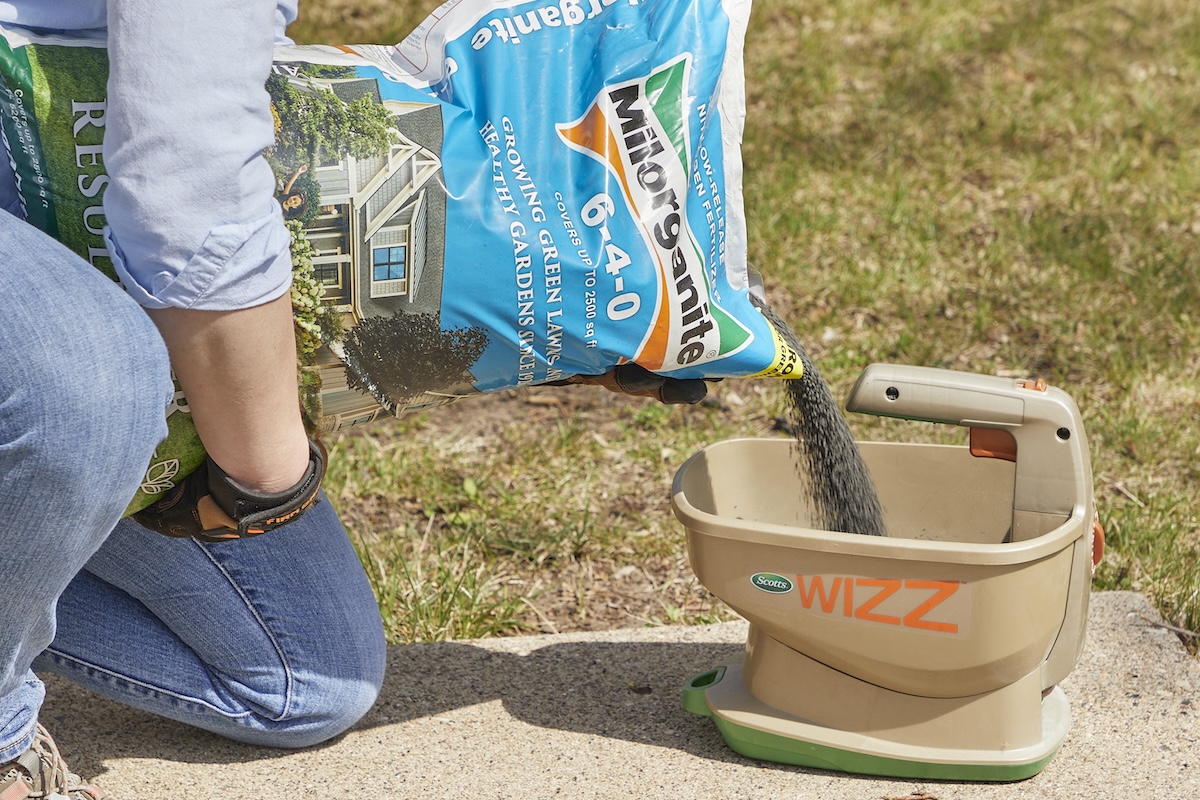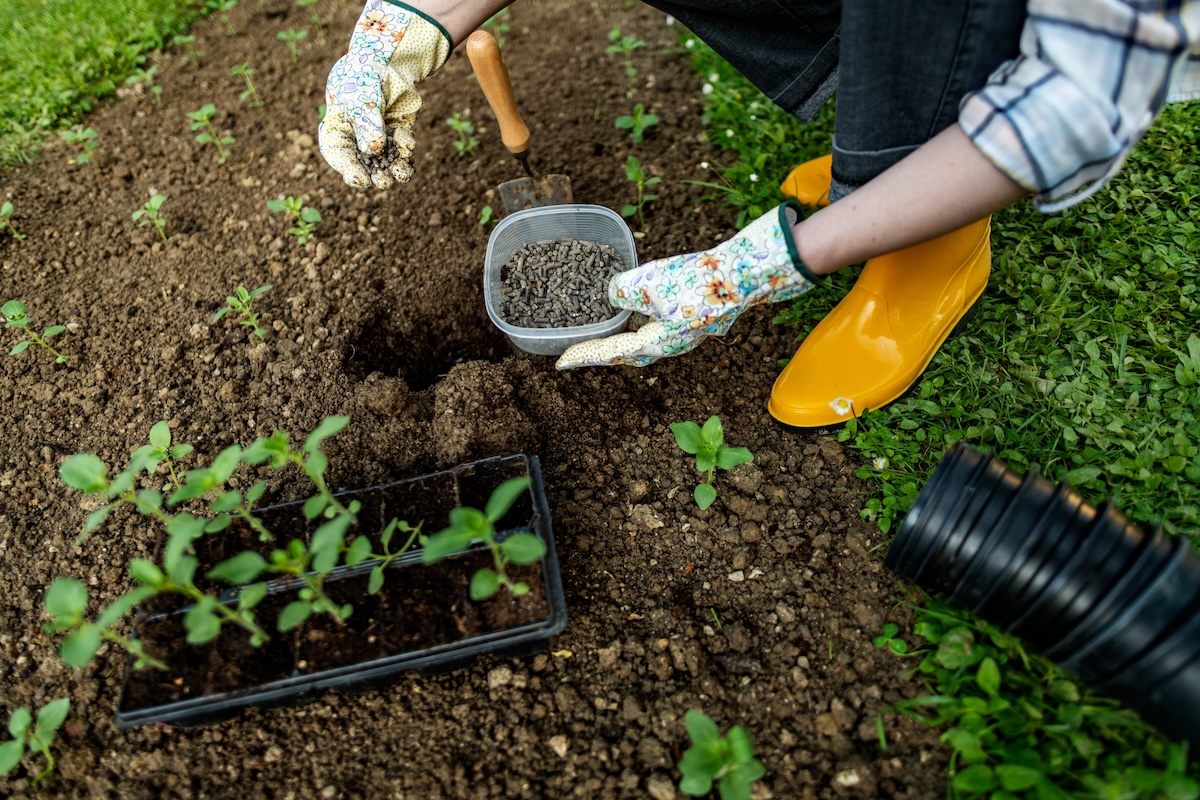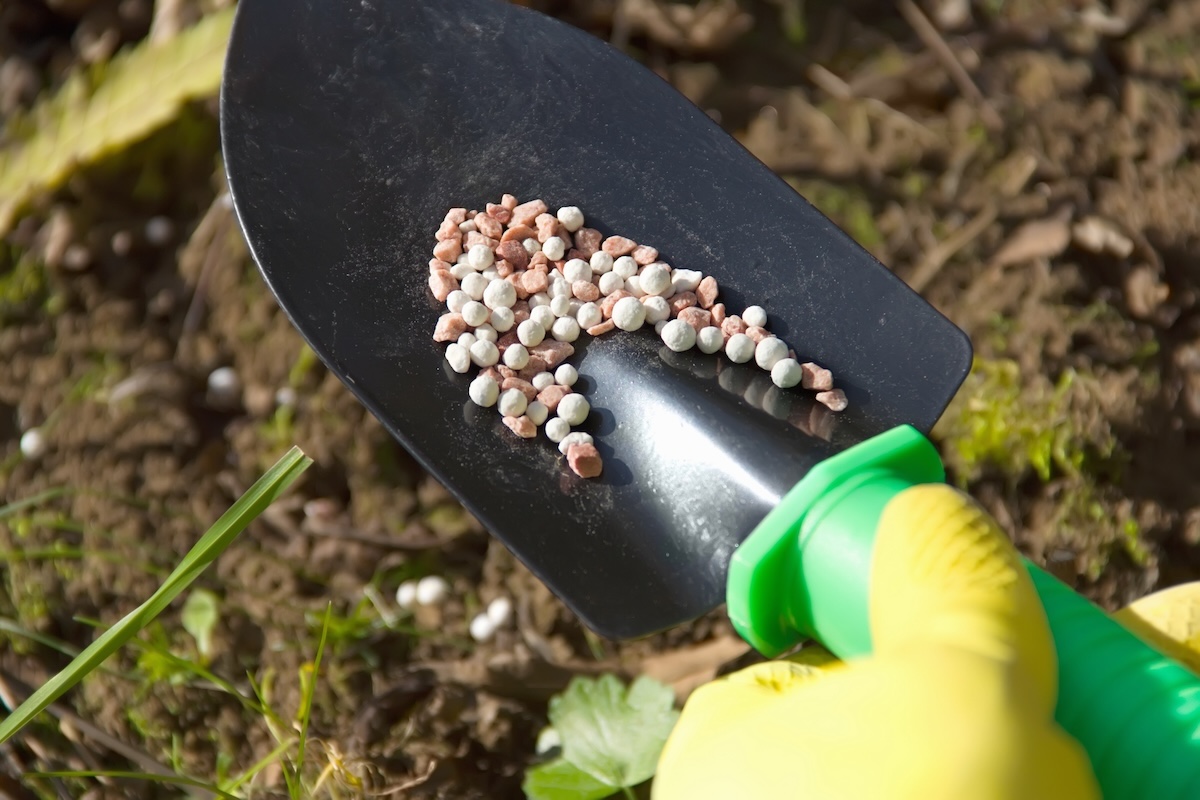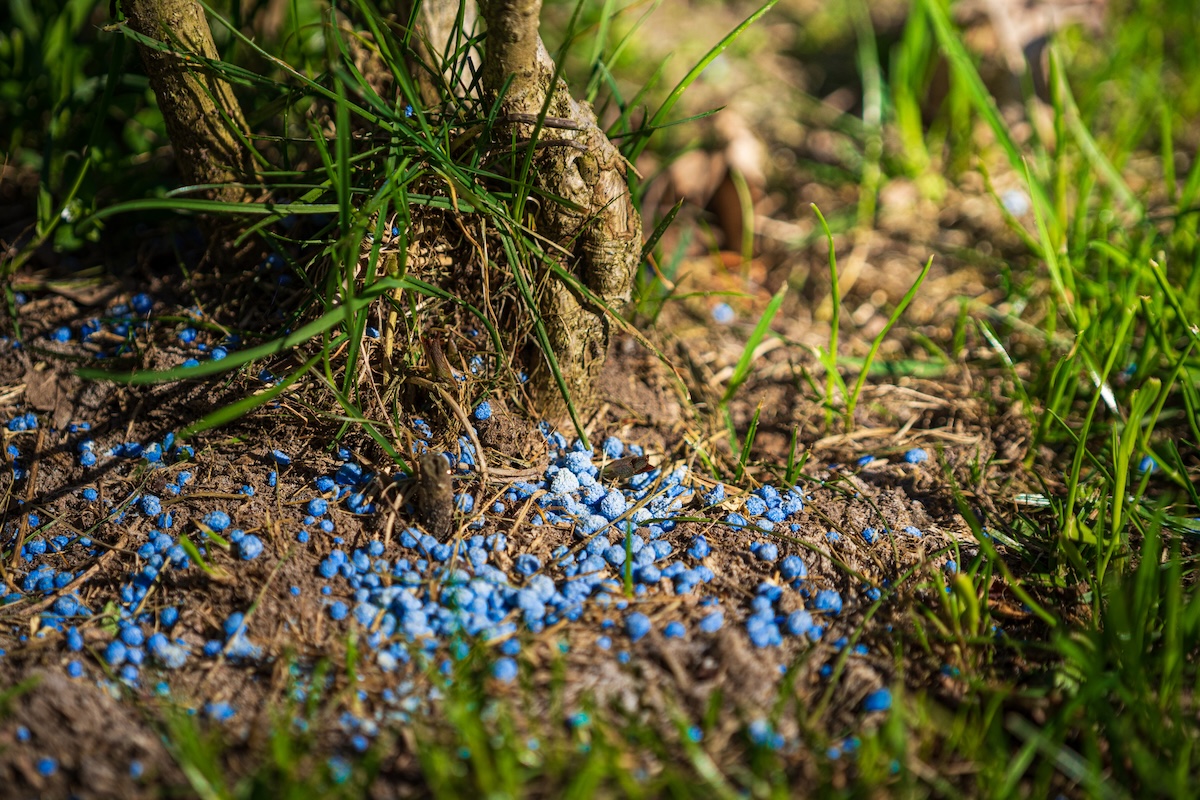We may earn revenue from the products available on this page and participate in affiliate programs. Learn More ›
Your lawn and garden need nutrients to grow and stay healthy. Soil is an important source of key nutrients but it doesn’t always contain them in adequate amounts. That’s why many homeowners take the time to consider what is fertilizer and what is fertilizer made of so they can properly add fertilizers as a supplement for their ornamental plants, vegetables, or turfgrass.
Different types of fertilizer come in various chemical forms and nutritional profiles, each of which affects your plants—and the environment—in a unique way. Read on to acquaint yourself with what types of fertilizers are available, and how to choose the right solution with confidence.
Why Fertilizer Is Important
Plants “are living things, made of carbon, hydrogen, oxygen, and nitrogen,” says Alec Kowalewski, PhD, associate professor and turfgrass specialist at Oregon State University in Corvallis, Oregon. “Plants need nitrogen more than anything else,” he says. After nitrogen comes “potassium and then phosphorus,” he says. These are the three primary nutrients in fertilizers.
In a perfect world, soil in our lawns or raised beds would provide everything a plant needs to grow. One reason that natives are low-maintenance plants is that they usually survive in their natural environment with little to no fertilizing. But vegetables, herbs, turfgrass, and fruiting trees might need a little more help.
Even a non-native ornamental plant might survive its conditions, but not grow as quickly, or bloom as profusely, without added or replaced nutrients from the best garden fertilizers. This is especially true after a few years of growing in the same spot, which can deplete the soil of nutrients. Lawns can benefit from fertilizing to help the grass green up and fill the space, winning the competition with weeds.
Primary Nutrients in Fertilizer

Complete fertilizer supplies plants with those three primary, or macro, nutrients: nitrogen (N), phosphorus (P), and potassium (K). This NPK value is a standard fertilizer number that should be prominent on fertilizer packaging and represents a percentage of each nutrient by volume:
- Nitrogen (N) supports leafy growth and green colors.
- Phosphorus (P) focuses plant energy on developing strong roots, flowers, fruits, and seeds.
- Potassium (K) supports overall balanced growth, helping plants resist damage from cold, drought, or diseases.
If a fertilizer is labeled as “balanced,” it contains equal amounts of the primary nutrients. An example is an NPK of 10-10-10. In addition to the primary nutrients, fertilizers often contain micronutrients, which plants also use but in smaller amounts than nitrogen, phosphorus, and potassium. Calcium, iron, and sulfur are examples of micronutrients.
Organic vs. Inorganic Fertilizers
“Organic fertilizer is in line with the natural process,” says Kowalewski. Plants are adapted to the natural cycles that release organic matter, and organic fertilizers mimic that slow process in improving soil. Organic formulas are derived naturally from plant, animal, or mineral remains. Therefore, they contain essential carbon, hydrogen, and oxygen in addition to at least one nutrient, like nitrogen, since they are derived from the byproducts or remains of organisms.
Organic Fertilizer Pros:
- Environmentally friendly
- Slow release of nutrients to mimic nature and add microbial activity
- Works long term
- Most do not add salts and acid to soil
Organic Fertilizer Cons:
- Higher cost upfront
- Are not meant for rapid action (not quick release)
Inorganic fertilizers, also called synthetic fertilizers, typically lack the carbon that binds up the nutrients in organic fertilizers. Although they can contain naturally occurring minerals or nutrients, they go through a manufacturing process that often includes the addition of petroleum industry byproducts.
Inorganic Fertilizer Pros:
- Works quickly, such as for greening a summer lawn
- Costs less upfront
Inorganic Fertilizer Cons:
- Excess synthetic nitrogen or other ingredients can contribute to greenhouse gases and affect downstream water supplies
- Lasts less time, and needs more frequent application than organic alternatives
- Is more likely to burn plants if applied incorrectly
- Does not add to microbial activity in soil
Types of Organic Fertilizer

Organic fertilizers work well for both garden and lawn applications, as long as gardeners recognize they take time to work and improve the structure and health of the soil. Most are made from plant or animal byproducts and include carbon. Some also contain minerals such as calcium or magnesium. All are considered slow-release fertilizers, nourishing plants over time.
Plant-Based Organic Fertilizers
In addition to adding plant-based organic fertilizers as needed, use homemade or commercial compost as a soil amendment to add organic matter as needed. Using cover crops such as legumes can improve soil health and return nitrogen to the soil in addition to applying some common plant-based organic fertilizers:
- Alfalfa meal: Made from ground-up alfalfa plants with nitrogen and other nutrients, as well as magnesium and iron.
- Cottonseed meal: Cotton manufacturing byproduct with nitrogen, potassium, and phosphorus; recommended for acid-loving plants as well as turfgrass, vegetables, and ornamentals.
- Kelp meal (seaweed): Made into a powder from dried seaweed (and maybe mixed with fish products), it has nitrogen, potassium, and phosphorus, as well as several micronutrients, and dozens of vitamins and minerals.
- Compost tea: Whether made at home or from commercial tea bags or powders, compost tea can serve as a soil amendment or an organic alternative to fertilizer, depending on the concentration. It is rich in nutrients and microorganisms.
Animal-Based Organic Fertilizers
Typically high in the essential nutrient nitrogen, animal-based fertilizers help promote strong starts for leafy plants in particular. Manure works more like plant-based compost to supply nitrogen, plus similar phosphorus and potassium levels, to many commercial fertilizers. However, its specific contents can vary. Always ensure manure has had time to break down (typically 4 to 6 months). Otherwise, ammonia and salts in the manure could burn plants.
- Fish emulsion: Made from whole fish or parts, this is an exceptional fertilizer with good nitrogen content, as well as protein, calcium, magnesium, and sulfur. Just beware that the odor can attract critters, including household pets.
- Bone meal: Ground-up bones (typically from cattle) have some nitrogen and calcium, but are high in phosphorus; the product often is used in flower bulb planting holes.
- Blood meal: Another slaughterhouse byproduct and a natural source of nitrogen, blood meal can supplement growth of any plant and might help lower soil pH.
Types of Inorganic Fertilizer

Synthetic fertilizers are formulated with chemically processed compounds such as ammonium nitrate or urea. They begin with natural elements such as mineral deposits in a chemical formula. A product might contain one or all of the primary nutrients, along with micronutrients. Over-applying inorganic products can lead to fertilizer burn, run-off into local water sources, and even the destruction of existing microorganisms in the soil. Always follow the manufacturer’s recommended amount and instructions carefully when using these and other synthetic fertilizers:
- Complete or compound fertilizer: A chemical blend that contains significant amounts of nitrogen, phosphorus, and potassium.
- Nitrogen fertilizer: Urea, nitrate, and ammonium sulfate supply nitrogen. “Urea is the most common quick-release nitrogen source,” says Kowalewski. Some nitrogen fertilizers also include sulfur, a secondary nutrient.
- Phosphorus fertilizer: Apply to support root and stem growth throughout a plant’s life cycle and boost flower or seed production. Types include superphosphate, concentrated superphosphate, diammonium phosphate, and ammonium polyphosphate. All are highly water soluble.
- Potassium fertilizer: Potassium helps ensure plants are taking up all nutrients from the soil, and can be boosted with potassium chloride, potassium sulfate, potassium nitrate, and others.
- Magnesium sulfate and calcium fertilizer: Acidic soils may be low in calcium, so consider boosting calcium if you’re trying to increase the alkalinity of your soil. Calcium and magnesium sulfate fertilizers usually are included in compound synthetics. Other sources of these nutrients are potassium sulfate, gypsum, and magnesium sulfate.
- Micronutrient fertilizer: This type of fertilizer is particularly useful in alkaline soils. “Usually, iron is the most important (micronutrient),” says Kowalewski. He said chelated forms of fertilizer often have iron and other micronutrients. The chelation helps make the micronutrients more available in the soil.
How to Choose the Right Fertilizer
The surest way to select the right fertilizer is to do a soil test. Kowalewski suggests testing every 3 years so you can tailor your NPK ratios or other nutrient needs. Only a soil test can reveal precise nutrient deficiencies for your plants. But you also can consider information on plant needs from their tags and credible sources, along with how quickly you want the product to work and how easy it is to apply.
Determine which nutrients plants need.
If you don’t want to test the soil and want to take a shot at adding balanced but helpful nutrients, Kowalewski suggests “something with high nitrogen, low phosphorus, and potassium in-between, like 20-5-10.” This reflects the concentration of the macronutrients in general plant matter, he says. It works on turfgrass, as well as shrubs, flowers, and vegetables.
The specific plant matters too. Native plants often need little to no additional nutrients, and most herbs grow well in slightly poor soil. But tomatoes need plenty of help to promote blooming and fruiting. If you’re unsure of the nutrients needed, look for fertilizer products labeled as specific to plants like tomatoes, evergreens, roses, or acid lovers like blueberries. And some lawn fertilizers might have an NPK formula of 30-0-4 to supply high nitrogen and no phosphorus.
Consider how quickly products work.
In addition to evaluating use of organic vs. inorganic fertilizers, look at how quickly the products act on plants. “We put down synthetic quick-release fertilizers because we want to see the grass turn green after we put it down or we want plants to grow” right after fertilizing, says Kowalewski. Quick-release products often need more frequent application than slow-release fertilizers. If you instead want to build soil health slowly, a slow-release organic product is better.
You can find some slow-release synthetic fertilizers, which have been formulated to time-release the nutrients. Slow- and controlled-release granular fertilizers are made of water-insoluble granules that may be coated with a semi-permeable material. They decompose and release their nutrients into the soil more gradually than liquid or quick-release granular varieties, supplying nutrients for several months.
Opt for the best or most convenient fertilizer form.
Fertilizer comes in many forms: as concentrated liquids for dilution, soluble powders, granules, or stakes. Each has advantages and disadvantages.
- Liquid fertilizers are water-soluble concentrates that require diluting in water before applying to soil with a hose-end sprayer or watering pot. An example is Miracle-Gro Liquid All Purpose Plant Food Concentrate.
- Dry powders like Jack’s Water-Soluble Fertilizer also require water and can rapidly release their nutrients into the soil after sprinkling or broadcasting and watering.
- Water-soluble granules are spread over the soil surface, mixed into the topsoil, and watered so the fertilizer decomposes and releases nutrients into the soil. They last longer than liquids, but less time than slow-release organics. An example is Jobe’s Synthetic All-Purpose Fertilizer. Most turfgrass fertilizers come in granular form and for best results, use a fertilizer spreader or broadcaster.
- Fertilizer spikes allow gardeners to avoid the hassles of storing fertilizer bags and spreading fertilizer. Drive the solid, water-insoluble sticks (like Jobe’s Fertilizer Spikes) into moist soil, where they decompose and release their nutrients. They work well for small trees, plants, and shrubs than for large trees or lawns. To prevent fertilizer burn, leave at least 3 feet between spikes.
Final Thoughts
Plenty of science goes into understanding and choosing fertilizers and knowing what fertilizer is used for, so the more you learn and study, the better. In addition to understanding whether a fertilizer is organic, its NPK ratio, micronutrients, and application form, store it properly for a longer-lasting product. Always follow product recommendations for how much to apply and when or how often to use a fertilizer. Base timing for fertilizing turfgrass on the lawn’s growing season. The same applies to ornamental plants. “If you have perennial plants, fertilize them in the spring and fall, and avoid summer and winter fertilization,” says Kowalewski.
FAQs
Most experts agree that organic fertilizers are better for plants and the environment. Organic fertilizers work slowly and improve overall soil health and structure. However, proper use of inorganic fertilizers can provide a quicker response in plants or address soil nutrient deficiencies. Specific nutrients and formulas depend on the plant type and soil makeup.
The best fertilizer for your lawn has more nitrogen than phosphorus, and potassium somewhere in the middle, ranging from an NPK of 20-5-10 to 30-0-4. Nitrogen helps keep grass green, and a product with a higher nitrogen percentage can work quickly to give a lawn that green, park-like look. Typically, granular formulas are easiest to apply by spreading and then watering.
All fertilizers start with natural elements. Organic fertilizers contain only natural byproducts of animals and plants. Inorganic, or synthetic, fertilizers can contain some natural elements, along with chemicals, or a completely chemical process. “Synthetic nitrogen comes from the Haber-Bosch process,” says Kowalewski. It uses hydrogen and atmospheric nitrogen in a special high-pressure, high-temperature chemical process.
In general, apply organic and other fertilizers (such as urea to prevent blossom end rot in tomatoes) at planting time. “That’s when the plant takes up most of its nutrients as it’s dividing cells and growing,” says Kowalewski. Likewise, fertilize in spring for most established plants, as growth reemerges. As many quick-release fertilizers only last a few weeks in the soil, so check the product directions for recommended frequency.

